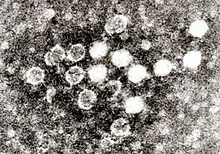Erythroparvovirus is a genus of viruses in subfamily Parvovirinae of the virus family Parvoviridae.[1][2] Primates serve as natural hosts. There are seven species in this genus. Diseases associated with this genus include fifth disease and skin lesions.[3][4]
| Erythroparvovirus | |
|---|---|

| |
| Virus classification | |
| (unranked): | Virus |
| Realm: | Monodnaviria |
| Kingdom: | Shotokuvirae |
| Phylum: | Cossaviricota |
| Class: | Quintoviricetes |
| Order: | Piccovirales |
| Family: | Parvoviridae |
| Subfamily: | Parvovirinae |
| Genus: | Erythroparvovirus |
Taxonomy
editThe following seven species are assigned to the genus:[4]
Structure
editViruses in Erythroparvovirus are non-enveloped, with icosahedral and round geometries, and T=1 symmetry. The diameter is around 18-26 nm. Genomes are linear, around 6kb in length.[3]
| Genus | Structure | Symmetry | Capsid | Genomic arrangement | Genomic segmentation |
|---|---|---|---|---|---|
| Erythroparvovirus | Icosahedral | T=1 | Non-enveloped | Linear | None |
Life cycle
editViral replication is nuclear. Entry into the host cell is achieved by attachment to host receptors, which mediates clathrin-mediated endocytosis. Replication follows the rolling-hairpin model. Dna templated transcription, with some alternative splicing mechanism is the method of transcription. The virus exits the host cell by nuclear pore export. Primates serve as the natural host. Transmission routes are oral and respiratory.[3]
| Genus | Host details | Tissue tropism | Entry details | Release details | Replication site | Assembly site | Transmission |
|---|---|---|---|---|---|---|---|
| Erythroparvovirus | Vertebrates | often restricted to erythroid progenitors | Clathrin-mediated endocytosis | Cell lysis | Nucleus | Nucleus | Aerosol |
References
edit- ^ Cotmore, SF; Agbandje-McKenna, M; Canuti, M; Chiorini, JA; Eis-Hubinger, A; Hughes, J; Mietzsch, M; Modha, S; Ogliastro, M; Pénzes, JJ; Pintel, DJ; Qiu, J; Soderlund-Venermo, M; Tattersall, P; Tijssen, P; and the ICTV Report Consortium (2019). "ICTV Virus Taxonomy Profile: Parvoviridae". Journal of General Virology. 100 (3): 367–368. doi:10.1099/jgv.0.001212. PMC 6537627. PMID 30672729.
- ^ "ICTV 10th Report (2018)".
- ^ a b c "Viral Zone". ExPASy. Retrieved 15 June 2015.
- ^ a b "Virus Taxonomy: 2020 Release". International Committee on Taxonomy of Viruses (ICTV). March 2021. Retrieved 10 May 2021.